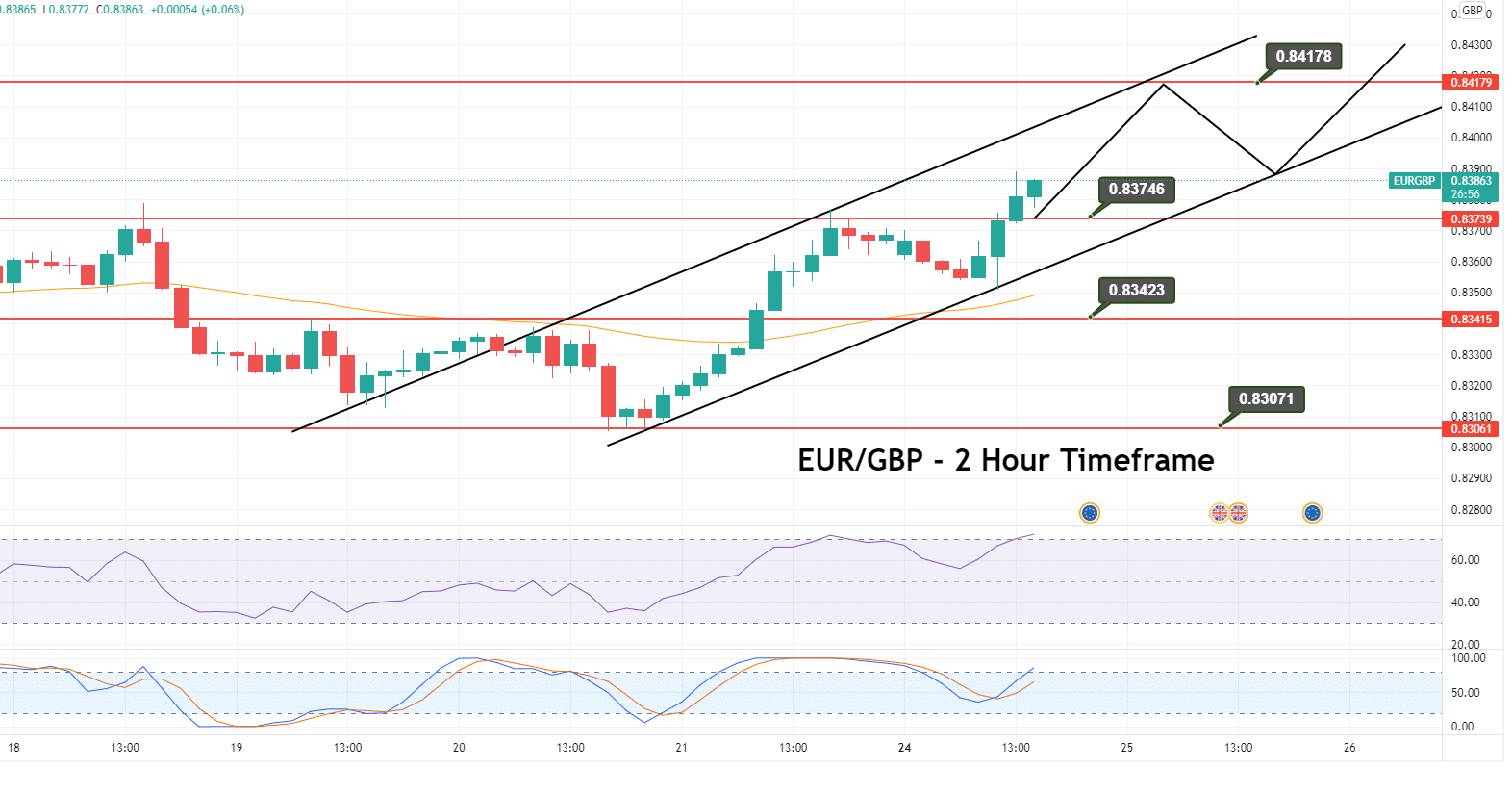EUR/GBP Breaks Above 0.8370 – What Could Trigger Further Uptrends?
Please note that we are not authorised to provide any investment advice. The content on this page is for information purposes only.
- Christine Lagarde said that inflation in Europe was unlikely to surge to the levels seen in the US.
- The Flash Germany PMI Composite Output Index rose to 54.3 in January from an 18-month low of 49.9 in December.
- EUR/GBP buying can be captured above the 0.8375 level to target the 0.8420 level.
During the European trading session, the EUR/GBP currency pair managed to trade bullish amid a series of positive economic events. The EUR/GBP hit an intra-day high above the 0.8385 level. The day before, EUR/GBP closed at 0.8364 after setting a high of 0.8378 and a low of 0.8314. Moreover, the pair reversed its bearish course on Friday and turned green amid the rising strength of the euro.
Refer to our trading guides to enhance your forex trading skills.
The ECB President’s optimistic remarks boost EUR demand
The single currency, the euro, gained strength across the board following the positive comments from the President of the European Central Bank. Christine Lagarde said that inflation in Europe was unlikely to surge to the levels seen in the US. These comments pushed the euro higher against its rival currencies, which ultimately added gains to the EUR/GBP pair.
Recently, the European Central Bank decided not to increase interest rates just like the BOE and the US Federal Reserve. However, the ECB’s decision was questioned. In response to these questions, Lagarde spoke about the European economic condition. The Eurozone has performed relatively better than the US and UK economies.
According to Lagarde, US demand was 30% above the pre-pandemic levels, and the US labor market was also at its worst, whereas Europe was almost at the pre-pandemic levels in respect to demand, and the labor market was also stable in Europe. Lagarde said that there was no need to increase interest rates as of yet as she was optimistic that inflationary pressures would slow down eventually.
In December, soaring energy prices pushed the Eurozone’s inflation to a new record high level of 5%. However, despite the increased level of inflation, the European Central Bank has said that it would not rush into raising interest rates like the US Federal Reserve Bank and the Bank of England.
The economic event outlook
At 19:57 GMT, consumer confidence remained unchanged at-9. On the British side, at 05:01 GMT, the GfK Consumer Confidence dropped to 19 from the forecasted-15 and weighed on GBP.
At 12:00 GMT, retail sales declined by 3.7%, against the anticipated 0.6%, and this weighed on the British pound. The unfavorable data from Britain added further gains to the EUR/GBP pair on Friday.
German economy shows resilience at the start of 2022
IHS Markit’s ‘flash‘ PMI data for January revealed an increase in business activity across the German economy, led by a stronger performance in the country’s manufacturing sector as supply constraints showed additional uncertain indications of easing. However, price pressures remained elevated, with input cost and output charge inflation rates remaining close to recent record highs.
The headline Flash Germany PMI Composite Output Index rose to 54.3 in January from an 18-month low of 49.9 in December. It indicates healthy growth in the private sector following a dip towards the end of 2021. The manufacturing sector led the recovery, recording its best five-month performance on the production front as the incidence of extended lead times on inputs fell to its lowest level since December 2020 (albeit it remained high by historical standards).
The service sector staged a minor recovery in January after shrinking in December as a result of the pandemic’s comeback and the initial tightening of restrictions. The Services Business Activity Index rose from 48.7 to 52.2, indicating a modest rate of expansion, while it remained at its second-lowest level in the previous nine months.
French economic growth slows again at the beginning of 2022
According to the most recent survey data, economic activity began in 2022 at a slower pace, with combined industrial and service sector production growth slowing to a nine-month low. The industrial sector expanded slightly, but service development slowed significantly, weighing on the French economy’s overall performance. The latest PMI statistics, once again, highlighted the consequences of the latest wave of COVID-19 infections, as well as ongoing supply chain delays, on economic activity.
In France, inflationary pressures have also increased, with production prices rising at the quickest rate on record, despite a larger rise in cost burdens. In January, the Flash France Composite Output Index decreased to 52.7 from 55.8 in December.
Bank of England policymaker Catherine Mann
On the other hand, Bank of England policymaker Catherine Mann said that the central bank needed to lean against inflation pressures. The BoE needs to stop expectations of higher price growth from getting entrenched in businesses’ wage and pricing decisions this year. The bank is widely expected to increase interest rates for the second time at its upcoming Feb. 3 meeting. In December 2021, the BoE became the first bank in the world to tighten monetary policy in response to post-pandemic inflationary pressures.
At that time, UK inflation reached its highest level in almost 30 years at 5.4%, which was well above the target of 2% set by the bank. Mann quoted the monthly survey and said that pricing and wage-setting businesses were not steady with inflation returning to the 2% target. She was waiting for the new BoE staff briefing, as it would help decide whether rates needed to be increased at the upcoming February meeting. The not-so-hawkish comments from Mann added weight to Sterling and pushed EUR/GBP higher.
EUR/GBP price forecast –Daily Technical Levels
Support Resistance
0.8365 0.8372
0.8362 0.8376
0.8358 0.8379
Pivot Point: 0.8369

EUR/GBP price forecast – Upward trendline to support at 0.8370
The EUR/GBP is trading at 0.8385, having violated the double top resistance at 0.8373 on the 4-hour chart. The pattern extended resistance at 0.8415 along with support at 0.8370. In the 2-hour timeframe, the EUR/GBP pair has formed an uptrend that supports a bullish bias. Alongside, the formation of three white soldiers’ patterns is also adding a bullish bias for cross-currency pairs. A spike in demand can slice through the 0.8385 level to each of the 0.8415 or 0.8460 resistance levels.
Typically, the ascending channel supports a bullish trend, therefore, the chances of buying remain strong above the 0.8370 level. The 50-day exponential moving average is holding at the 0.8350 level. It’s supporting the buying trend in the EUR/GBP pair. The RSI and Stoch RSI are supporting an uptrend in the EUR/GBP pair; therefore, EUR/GBP buying can be captured above the 0.8375 level to target the 0.8420 level.
On the bearish side, EUR/GBP may find immediate support at 0.8370. A break below this level can drive a further downtrend until the 0.8360 or 0.8340 level. All the best, and stay tuned for more updates!





